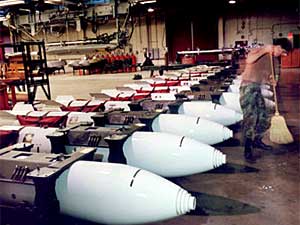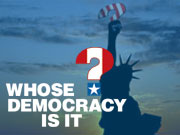|
Audio
Photos
Resources
Your Voice
|
Evidence of democracy
November 7, 2003
 |
| Paul Shambroom photographed various nuclear weapons sites across the country -- which he says are the government's ultimate symbols of power. These are B83 nuclear gravity bombs, each with estimated one-megaton yield, at Barksdale Air Force Base, Louisiana. (Photo courtesy of Paul Shambroom) |
St. Paul, Minn. — Power fascinates photographer Paul Shambroom -- specifically, American power. He's photographed industrial factories and corporate headquarters, both symbols of America's economic power. But then, he began to wonder -- what is at the heart of America's power?
"I started thinking about how we define ourselves as a nation, and which part of our national identity defines our power," says Shambroom. "I had the idea that nuclear weapons were the core of what made us powerful."
Shambroom asked to be admitted into some very high security facilities. Many were areas where no member of the public had been before.
 | |||
"The main surprise was that I got in to the places I did get into," says Shambroom. "I was constantly amazed and in a state of mind where I wanted to pinch myself and just check to make sure that, well yeah, I really am standing next to 24 one-megaton nuclear bombs."
The experience was awe-inspiring on many levels, Shambroom says. Not just in the sheer potential power of the bombs he photographed, but in his country's willingness to let him document its nuclear arsenal.
"I had a change of attitude about the democratic process and how it works in this country," says Shambroom. "I found myself feeling more patriotic, in some ways that really suprised me a lot."
Still, Shambroom describes his patriotism as "with a small 'p.'" His next series focused on what might seem a more mundane topic -- public meetings. His goal was to capture both the theatrical and weighty atmosphere that surrounds the use of democratic power at its most basic level.
Over the course of four years, Shambroom attended more than 150 city council meetings in small towns across the country. The photographs often resemble one another. They each depict a group of people seated at a table. Individuals are seen deep in thought, with heavy looks in their eyes.
The images are printed onto canvas and then varnished. The rich, painterly colors and tones evoke the iconic image of the Last Supper. What the photographs don't capture is what was on the other side of the lens. Often, Paul Shambroom was the only person in the audience.
|
For me there's a reality gap between the disempowerment that people seem to feel in this country, and the fact that so few people actually bother to raise their hand and speak their mind. When they do, they're generally heard.
- Photographer Paul Shambroom |
"If there is a problem that people are bothered about in small towns -- they're there and they're very vocal and they're very eloquent in stating their concerns," says Shambroom. "But if there are no problems that affect them directly, often times people aren't showing up."
Shambroom says he saw the lack of attendance as a symptom of people's lack of confidence in the democratic process.
"For me there's a reality gap between the disempowerment that people seem to feel in this country, and the fact that so few people actually bother to raise their hand and speak their mind. When they do, they're generally heard," says Shambroom.
"It doesn't mean that you're going to get everything you ask for. But particularly on the small town level, if someone is going to bother to go down to the city council meeting on Thursday night -- as long as they're respectful and polite -- their concerns are generally heard. And they carry as much weight as the 1,200 other people in the town that didn't bother to show up -- combined," Shambroom says.
Shambroom says he's heartened by the number of Americans who still volunteer their time to keep the democratic process running. He just wishes there were more of them.
Paul Shambroom's most recent show is on display at the Museum of Contemporary Photography in Chicago. The exhibition juxtaposes his images of nuclear bombs with those of the city council meetings. Associate Curator Karen Irvine says bringing the two series together raises questions for her about the disconnect between local action and federal process.
"The people in the meetings pictures are making decisions about buying new stop signs, or paying police officers, or traffic violations and tattered flags at City Hall," says Irvine. "But would they actually have control over the government saying, 'Hey, we're going to build a missile silo next door to your house?' Probably not."
Irvine says she hopes viewers will be inspired to question the extent of their own participation in and control over the democratic process.
Photographer Paul Shambroom says he's not making any judgments about democracy within his photographs, but he's amazed by how many people see their own attitudes about power mirrored in his work. Some find his images incredibly patriotic -- a tribute to the hard working men and women who keep the United States strong. Others find the images condemning evidence of the lack of a real democratic process in our country.
|
News Headlines
|
Related Subjects
|

